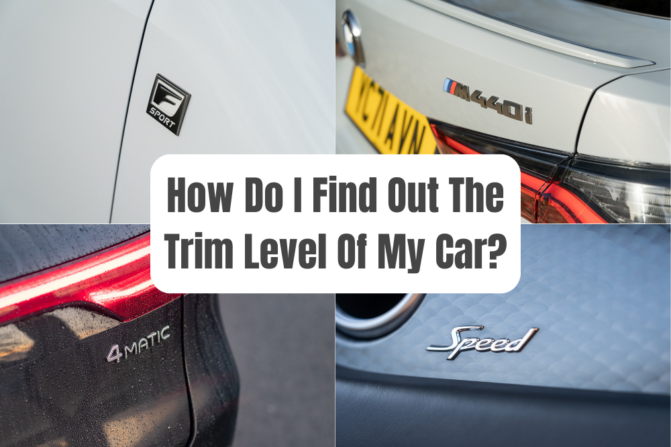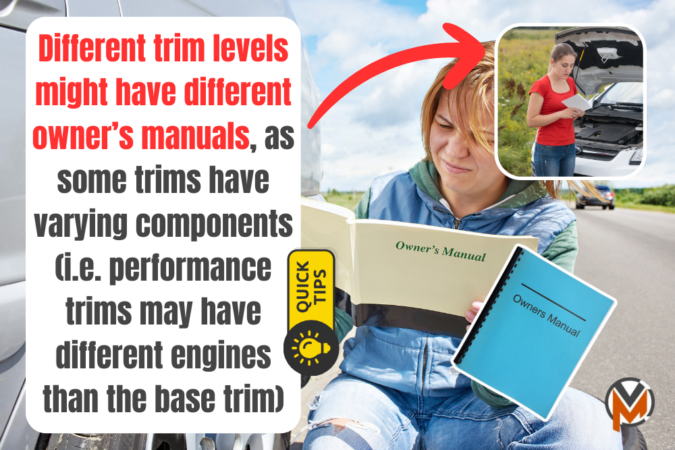Whether you need to buy the right replacement parts or if you want to check your car’s resale value, knowing your car’s trim level is essential. However, many owners aren’t sure about where to find it, but thankfully, you’re in the right place! If you’re thinking about ‘how do I know what trim my car is’, here are 5 simple ways you can find the trim level:
- Looking around your car for special trim badging or logos
- Checking inside your car’s owner’s manual
- Checking with your car’s insurance provider
- Try checking your car’s VIN number with a lookup tool
- Consider asking the dealership that sold you the car
As you can see, it’s pretty easy to figure out what specific trim level is fitted onto your car. Oftentimes, all you really need to do is look around your car and see if there are any distinct trim badges. Or, you could always find those details in your car’s owner’s manual. Alternatively, you could ask the dealer who sold you the car or consider doing a VIN check.
With this in mind, here’s a more in-depth look at some of the most effective ways to you can find out your car’s trim level:
How Do I Know What Trim My Car Is – 1) Look Around For Trim Badges
Carmakers often have badges of the trim level in or around the car. This is to make it easier to differentiate and spot at the dealership. The most common place to find these trim-level badges is usually at the tailgate/liftgate. Some may also have their trim level on the front fenders, just a little behind the front wheels, under the side mirrors.
However, the latter is more common in international-market cars rather than North American cars. Still, doesn’t hurt to look and see. You can also take a look inside the car. While not quite as common, some carmakers put a badge or a plaque inside the car that says what trim level the car is. You’ll often find this on the passenger-side dashboard or the door sills.
For better or worse, this trend of badging and adding plaques to a car has been falling out of fashion in recent years. Many cars don’t have their trim level badges or logos anywhere on the car anymore. This is probably because a lot of customers often choose to de-badge their cars, removing any sort of badges and logos on their cars to give them a cleaner look.
Consequently, carmakers now often don’t badge their cars, and they’ll usually only put the model name on it. This can make it difficult for you to identify your car’s trim level just by looking at it. The only exceptions are super rare or limited edition cars. The latter might contain some sort of plaque that shows you the production serial number, like “Car #17/100“.
How Do I Know What Trim My Car Is – 2) Check Inside Owner’s Manual
Another way to find out is to take a look at your car’s owner’s manual. Oftentimes, different trim levels may require different owner’s manuals and guides since there might be a difference in major components. If that’s the case, you should be able to find out your car’s trim by taking a look at the owner’s manual. If it’s there, it’s going to be on the front page.
This is usually true if you have a higher-end trim since they often have a different engine than lower-trim versions. For example, the ‘Wildtrak’ Ford Bronco is the only trim that comes with the 2.7L V6 engine as standard. Otherwise, it’s optional in the other trims. If it’s not on the manual, check for the documents that may come with the manual.
The bill of sale, registration, and title are unlikely to include the trim level. However, your dealer may slip in delivery forms, invoices, and other documents when they deliver the car. These forms are likely to state what trim your car is, along with other useful information. If you can find these papers, you should be able to find out what trim level your car is.
Common Trim Level Naming Conventions Across Brands
On that note, just so you have an idea of how different automakers structure their trim levels, we’ve prepared a little table for you. This showcases how different automakers name, position, and show off their varying trim levels, from entry-level to high-end:
| Brand | Entry-Level Trim | Mid-Level Trim(s) | High-End Trim(s) | Performance/Luxury Trim(s) |
|---|---|---|---|---|
| Toyota | L, LE | XLE, SE | Limited, Platinum | TRD Pro, GR, Capstone |
| Honda | LX | Sport, EX | EX-L, Touring | Type R, Elite |
| Ford | XL | XLT, Lariat | King Ranch, Platinum | Raptor, ST |
| Chevrolet | LS | LT, RST | Premier | High Country, Z71, ZR2 |
| Nissan | S | SV | SL, Platinum | NISMO |
| Hyundai | SE | SEL, N Line | Limited, Calligraphy | N (Performance) |
| Kia | LX | S, EX | SX, SX Prestige | GT, GT-Line |
| BMW | Standard (e.g., 330i) | M Sport, xDrive | M Performance (e.g., M340i) | M (e.g., M3, M5) |
| Mercedes-Benz | Base (e.g., C 300) | 4MATIC, AMG-Line | Exclusive, Pinnacle | AMG (e.g., AMG C 63) |
| Audi | Standard (e.g., A4) | S Line, Technik | Prestige | S, RS (e.g., RS7) |
| Volkswagen | S | SE | SEL, SEL Premium | GTI, R |
| Subaru | Base | Premium | Limited, Touring | WRX, STI, Wilderness |
How Do I Know What Trim My Car Is – 3) Check With Insurance Provider
When you first get insurance for your car, your insurer is likely to have inspected the car for various things including the trim level. This is because a trim level can affect a car’s insurance premium. As an example, here’s an interesting example: A base model Porsche Macan is likely to have a higher insurance rate than the high-end Porsche Macan GTS.
It seems that the insurance industry have found that lower-trim cars are more likely to be driven. Meanwhile, higher-end trims, especially luxury cars, are less likely to be driven daily and kept only as garage queens. So, even though the higher-end trims are more expensive to cover, lower trims are more likely to get into an accident since they’re driven more.
Hence the higher insurance premiums. Since your car’s trim level is an important piece of data for your insurance provider, they likely have this information in their database. Check your mail and email for exchanges with your insurer that may contain this information. If you can’t find it, give them a call and see if they can provide you with this information.
How Do I Know What Trim My Car Is – 4) Check Your VIN Number
So, you still can’t find it? No worries, because you should be able to know what trim your car is by decoding the Vehicle Identification Number (VIN). The VIN, as it suggests, is a 17-digit unique identification code for your car. It contains plenty of information including the country of origin, brand, model, engine size, model year, and of course, the trim level.
You can find your car’s VIN on the bottom of the windshield, usually on the driver’s side. If it’s not there, it’s often on the driver’s side door around the door sills. If you can’t find it, your car’s title and registration will have this information. To decode your car’s VIN, you can use a free VIN lookup & decoder. Note, that some of these services are paid.
Simply enter your car’s VIN in there, and it will return a result on your car’s information. As I mentioned earlier, some of those VIN decoding services are paywalled. But, most of them should at least show the trim by default. Also, the 17-digit VIN system was standardized in the 1980s. If your car is from 1981 or older, your VIN will be between 11 to 17 digits long.
Best VIN Decoder Lookup Tools
Speaking of, we’ve had the liberty of analyzing some of the best (free and paid) VIN decoder lookup tools out there. So, if you need to do a VIN check on your car, either to find the trim level or otherwise, here’s where you could do it:
| Service Name | Type | Key Features |
|---|---|---|
| NHTSA VIN Decoder | Free | Official government resource; provides basic vehicle details including make, model, and year. |
| VINCheck.info | Free | Offers comprehensive vehicle history reports, including accident history and title information. |
| AutoZone VIN Decoder | Free | Provides basic vehicle specifications and assists in finding compatible auto parts. |
| CARFAX | Paid | Delivers detailed vehicle history reports, including service records, ownership history, and reported accidents. |
| AutoCheck | Paid | Offers vehicle history reports with an emphasis on auction data and a proprietary scoring system. |
How Do I Know What Trim My Car Is – 5) Ask The Car Dealership
One other way to find out how do I know what trim my car is by asking a dealership. A dealership can often provide the answers you’re seeking, regardless of whether you bought your car there. Most car dealerships maintain extensive databases and can give insights on trim levels based on a car’s specifics. They could also pull information from the automaker at large.
Usually, it’s best to visit the dealership that caters to your car’s brand. So, if you own a Lexus, go to a Lexus dealership. Specialists at these establishments can frequently identify a car’s trim with just a glance. Especially, if your car is a recent model. Additionally, if you’ve had your car serviced at a dealership, the service records also detail the trim level of your vehicle.
Why Learning The Trim Level Matters
So, you might be wondering… Why does it matter that I need to learn ‘how do I know what trim level my car is’? Well, it actually does matter quite a lot, and it’s more than just helping you identify a nameplate. Your car’s trim level directly impacts repair costs, insurance rates, resale value, and available features! Understanding your vehicle’s trim level is also important when seeking accurate car insurance quotes. Auto insurance is mandatory in most states, but with so many coverage options and providers, comparing quotes from best car insurance companies can help you find the best fit for your needs and budget. Here’s what I mean:
- Replacement Parts & Repairs – Bear in mind that higher trim levels often come with larger wheels, different brake systems, upgraded suspension, and premium interior materials. As such, if you or a workshop need to order replacement parts, ordering the wrong ones could lead to compatibility issues or costly returns.
- Insurance Costs – Almost every insurer will calculate your insurance premiums based on trim level. In short, a base model car may have lower replacement costs but higher premiums if it’s driven more frequently. Meanwhile, you’ll often find that a top-tier trim may be pricier to repair but cheaper to insure due to limited use.
- Resale Value & Trade-In Offers – When it’s time to sell or trade in your car, dealerships, and private buyers look at the trim level when determining your car’s market value. In layman’s terms, a fully loaded trim with premium features like leather seats, a sunroof, and safety tech can add thousands to your car’s resale price compared to the base model.
- Performance & Driving Experience – For enthusiasts, in particular, some trims come with larger engines, sportier suspensions, or enhanced driver-assist features that make a big difference in how a car drives and the driving experience. As such, knowing your trim ensures you get the right information when comparing models or upgrading.



